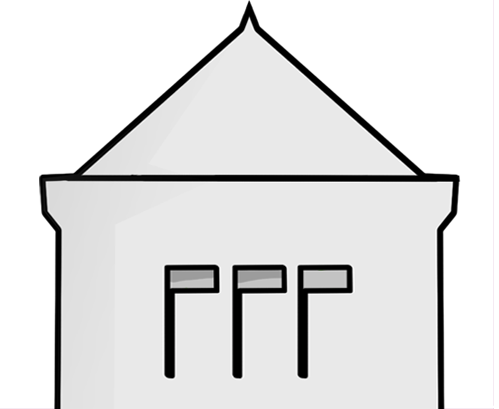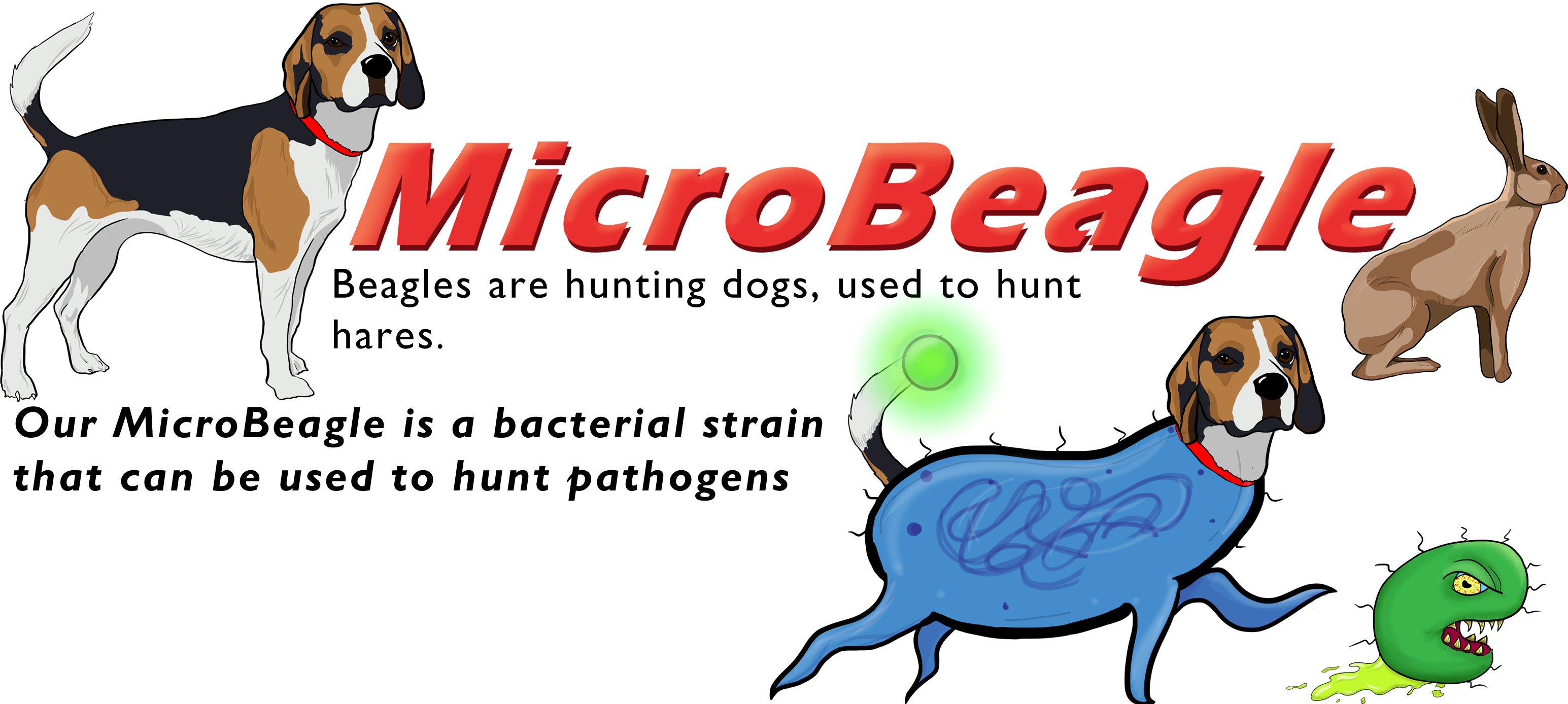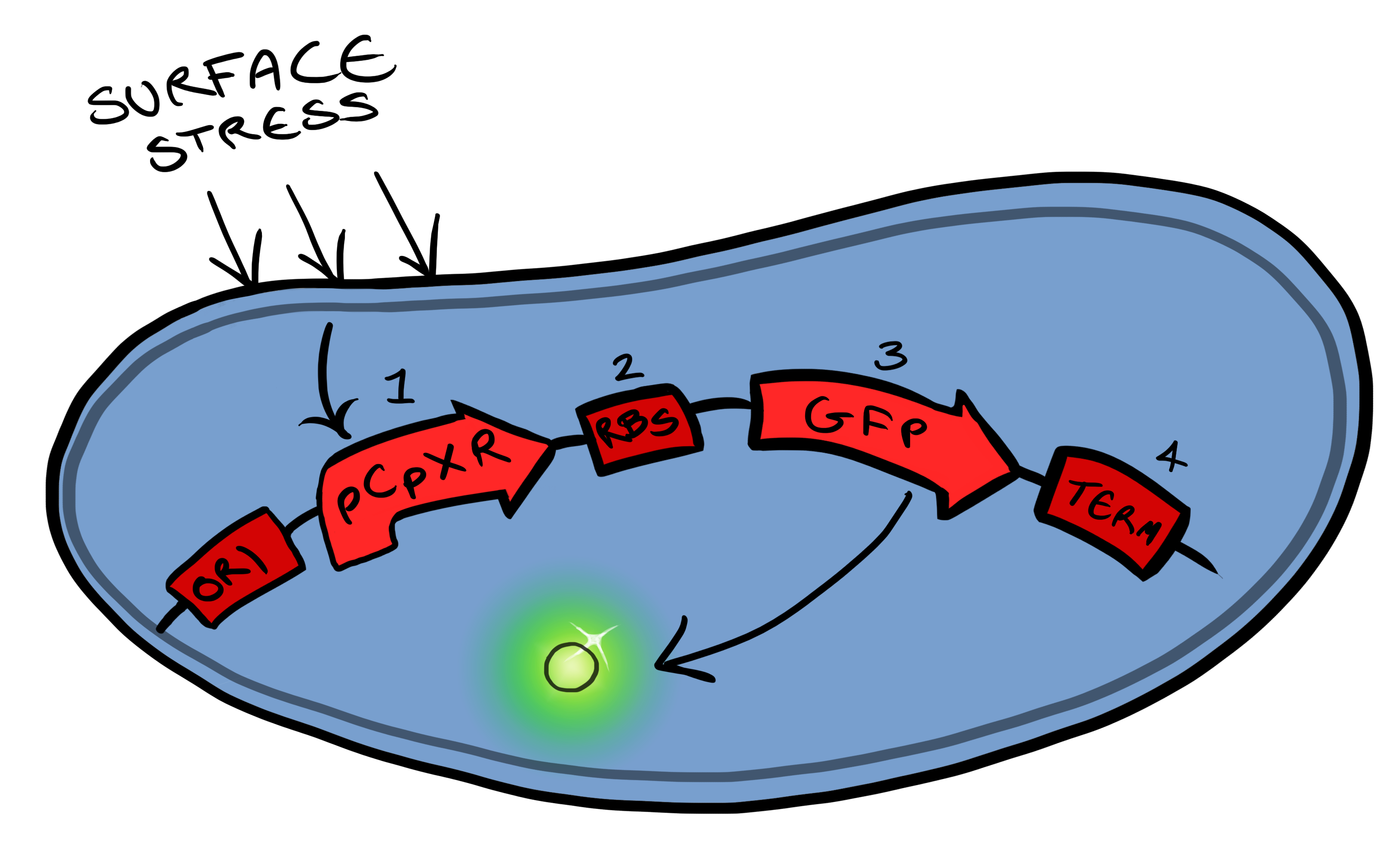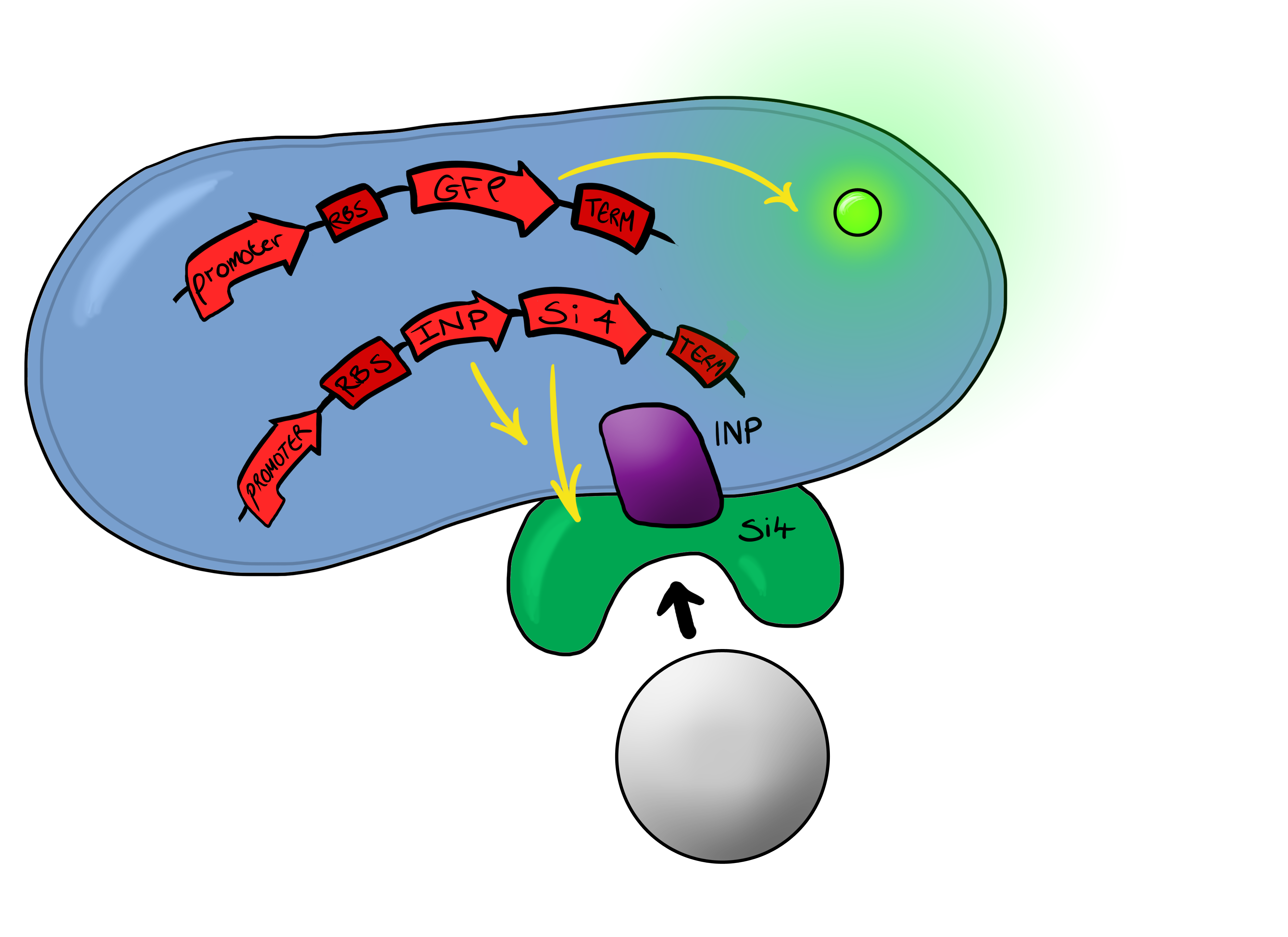Team:Leeds/Project
From 2013.igem.org
(Difference between revisions)
| Line 48: | Line 48: | ||
</div></div> | </div></div> | ||
<br> | <br> | ||
| - | + | =='''Our Project'''== | |
| - | What is MicroBeagle I hear you cry? | + | ===What is MicroBeagle I hear you cry?=== |
| + | Well, MicroBeagle is a E.coli cell that has been modified so that it can “hunt down” pathogens. Just like a Beagle, the hunting dog, searches and finds rabbits and hares, our MircoBeagle finds pathogens and detects them through physical binding! By utilising the Cpx pathway and GFP we hope to create a new biosensor that gives results that can be seen with the naked eye. | ||
<br> | <br> | ||
| - | + | ==Why is the MircoBeagle a useful device?== | |
| + | There could be many different possible uses for our device as the pathogen detection mechanism we are using is modular and can easily be tailored to individual needs. This is achieved by swapping out the gene coding the binding domain to suit your need. We see the MircoBeagle being used for testing blood samples, detection of heavy metals and, our main focus, detection of pathogens in water samples. | ||
<br> | <br> | ||
| - | Why is the | + | ==Why Water Testing is so important?== |
| + | Detecting pathogens in water is a really important application as 3.4 million people a year die from water related diseases. | ||
| + | 768 million people in the world do not have access to safe water. This is roughly one in ten of the world's population, the majority of which is caused by faecal contamination: poor sewage systems that flow back into the water supply | ||
| + | The issue is actually more complex and subtle than just direct health problems, the knock on economic problems that result from poor sanitation are phenomenal | ||
| + | Lack of water, sanitation and hygiene costs Sub-Saharan African countries more in lost GDP than the entire continent gets in development aid | ||
| + | The figures are shocking and we as a team want to create something that may, in the future, help to reduce those numbers. | ||
| + | So our challenge was to address this issue using a novel synthetic biological approach, hence the MircoBeagle was born! | ||
<br> | <br> | ||
| - | + | ===Below is a summary of our Biosystem development strategy...=== | |
| - | + | ||
| - | + | ||
| - | + | ||
| - | Below is a summary of our Biosystem development strategy... | + | |
<br> | <br> | ||
==Phase I== | ==Phase I== | ||
We split our project into self-contained phases, to help better organise ourselves, but also lay out a road map for our own future work within and without iGEM. The first of these looks at developing, characterising and producing basic Biosystems. | We split our project into self-contained phases, to help better organise ourselves, but also lay out a road map for our own future work within and without iGEM. The first of these looks at developing, characterising and producing basic Biosystems. | ||
===Biosystem 1=== | ===Biosystem 1=== | ||
| - | [[File:Leeds_bb1schematic.png|left| | + | [[File:Leeds_bb1schematic.png|left|500px|Cartoon schematic of Biosystem 1|link=|frameless]] |
| - | Biosystem 1 is a very simple modification of the Cpx promoter in ''E. coli'' to produce a fluorescent reporter when the cell is under membrane stress. We will then characterise and test the insertion following the work by [http://www.ncbi.nlm.nih.gov/pubmed/11830644 ''Otto & Silhaevy 2001''] in which glass beads were used to induce hydrophobic membrane stress. What we would hope is that when we add our cells to a vial containing similar hydrophobic beads we can detect fluorescence emissions confirming that our biobrick is working as we had hoped. Bio bricks we | + | Biosystem 1 is a very simple modification of the Cpx promoter in ''E. coli'' to produce a fluorescent reporter when the cell is under membrane stress. We will then characterise and test the insertion following the work by [http://www.ncbi.nlm.nih.gov/pubmed/11830644 ''Otto & Silhaevy 2001''] in which glass beads were used to induce hydrophobic membrane stress. What we would hope is that when we add our cells to a vial containing similar hydrophobic beads we can detect fluorescence emissions confirming that our biobrick is working as we had hoped. We know that membrane stress can be caused by many stimuli, so we have also looked at the effect different membrane stresses cause on the florescence achieved; these membrane stresses include, pH, temperture and detergent concentration. |
| + | <br> | ||
| + | Bio bricks we used to assemble Biosystem 1 are: | ||
BBa_K135000 pCpxR promoter responds to membrane stress | BBa_K135000 pCpxR promoter responds to membrane stress | ||
BBa_K081012 Green fluorescent protein generator. Contain ribosome binding site and terminator | BBa_K081012 Green fluorescent protein generator. Contain ribosome binding site and terminator | ||
<br style="clear:both"/> | <br style="clear:both"/> | ||
===Biosystem 2=== | ===Biosystem 2=== | ||
| - | [[File:Leeds_Device2schematic.png|right| | + | [[File:Leeds_Device2schematic.png|right|500px|Cartoon schematic of Biosystem 2|link=|frameless]] |
| - | Simultaneously, we will be developing a | + | Simultaneously, we will be developing a Biosystem that is suited for physical attachment and detection of particles. This will work using Ice Nucleation Protein (INP) to display a oligo-peptide of our choice on the outer-membrane of our ''E. coli'', initially this will be a peptide capable of binding silica beads allowing us to create a model system of pathogen detection. INP is a transmembrane protein that expresses any sequence that is placed on the C-terminus of its gene on the outer surface of the cell. |
| + | <br> | ||
| + | The cells producing this receptor complex will also be constitutively producing a fluorescent reporter, GFP, to allow for its detection during the characterisation experiments but this time the focus of Biosystem 2 is on the adhesion proteins being used. | ||
| + | <br> | ||
| + | The Biobricks we used for this Biosystem are: | ||
BBa_K081012 for the Green fluorescent protein generator which contain a ribosome binding site and terminator. | BBa_K081012 for the Green fluorescent protein generator which contain a ribosome binding site and terminator. | ||
BBa_K523008 is the Ice nucleation protein any sequence added to the C-terminus of the INP will be transported to cell membrane and be displayed on the surface of the cell. | BBa_K523008 is the Ice nucleation protein any sequence added to the C-terminus of the INP will be transported to cell membrane and be displayed on the surface of the cell. | ||
| Line 77: | Line 87: | ||
BBa_B0034 a strong ribosome binding site and finally | BBa_B0034 a strong ribosome binding site and finally | ||
BBa_J23119 a Constitutive promoter | BBa_J23119 a Constitutive promoter | ||
| - | |||
| - | |||
<br> | <br> | ||
==Phase II== | ==Phase II== | ||
| Line 84: | Line 92: | ||
===Biosystem 3=== | ===Biosystem 3=== | ||
[[File:Leeds_Device3chematic.png|left|400px|Cartoon schematic of Biosystem 3|link=|frameless]] | [[File:Leeds_Device3chematic.png|left|400px|Cartoon schematic of Biosystem 3|link=|frameless]] | ||
| - | Biosystem 3 brings together BS1 and BS2 in one plasmid | + | Biosystem 3 brings together BS1 and BS2 in one plasmid; the genes that code for the INP and the Si4 binding domain are now located on the same plasmid as the CpxP promoter and the GFP generator. The effect of this is that when the silca bead binds to the Si4 binding domain connected to the INP protein and causes surface stress the CpxP promoter will be induced. This will cause GFP to be produced and this will act as a visible signal that the 'pathogen' has been detected. |
<br style="clear:both"/> | <br style="clear:both"/> | ||
==The Cpx Pathway== | ==The Cpx Pathway== | ||
Revision as of 13:25, 22 September 2013
 "
"













